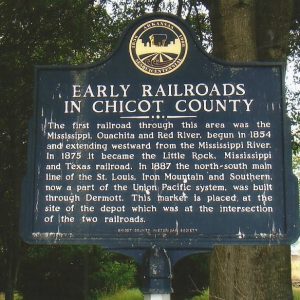calsfoundation@cals.org
Mississippi, Ouachita and Red River Railroad
The Mississippi, Ouachita and Red River Railroad Company (MO&RR) was the first railroad to begin construction in Arkansas. Chartered in 1852 by John Dockery of Columbia County, the railroad began at Eunice (Chicot County), south of Arkansas City (Desha County), in 1854. At the onset of the Civil War, the railroad was incomplete, extending approximately seven miles south and west from the Mississippi River. Completion of construction and actual operation of the railroad did not occur until well after the Civil War. The road never made a profit and was merged with the Little Rock, Pine Bluff and New Orleans Railroad in 1873.
The first articles of incorporation for the MO&RR were filed with the State of Arkansas by John Dockery on January 8, 1851. Dockery, a significant land owner in Lamartine (Columbia County), near Waldo (Columbia County), was largely responsible for the founding of the railroad and possessed the most shares. Incorporation followed a well-attended railroad convention that took place in Camden (Ouachita County) in December 1851. Dockery held a prominent position at the convention, where the members decided, not surprisingly, that a railroad in southern Arkansas was absolutely necessary, primarily because the Red and Ouachita rivers were not navigable for much of the year. This fact, they felt, combined with a lack of internal improvements, prohibited southern Arkansans access to the Mississippi River, eastern markets, and New Orleans, Louisiana.
The new railroad was to begin at, or near, Gaines Landing (Chicot County) and continue through, or near, Camden to Fulton (Hempstead County). From Fulton, the company was to build its railroad to a location on the border between Texas and Arkansas. The railroad was surveyed in 1853–1854. Despite the difficulty of raising investment capital, the railroad hired renowned engineer Lloyd Tilghman as its chief engineer. After studying the Mississippi River at several locations, Tilghman moved the railroad from Gaines Landing to Ferguson’s Point near the plantation of J. L. Martin. At this location, above Island No. 80, they already had a donation of sixty acres, and the river was straight with good depth and a good shore. It also had ample land for railroad shops, a rail yard, and a town. Tilghman planned an air-line route from this point that passed south of Monticello (Drew County) through Warren (Bradley County) to Camden.
Likewise, Tilghman moved the western terminus of the railroad from Fulton to the Cut-off on the Red River. The new location was at William Wynne’s new house in the vicinity of what is now Garland (Miller County) some nineteen miles south of Fulton. This new path would take the road to Lamartine and down Beech Creek, crossing the Dorcheat Bayou half a mile north of the main road to Lewisville (Lafayette County). Tilghman’s recommended route from Camden to the Red River is very similar to the route later built by the St. Louis Southwestern Railway. Tilghman claimed that this new route would make the Red River a tributary of the railroad. He noted that the Red River country above the Great Raft, because of the “supineness and imbecility of our Government, [would] remain, I fear, forever a barrier to the commerce of the vast regions above.”
Tilghman announced on February 22, 1854, that he had let contracts and made payments on construction of twenty miles of railroad west of the Mississippi and Ouachita rivers. On July 6, 1854, a day-long ground-breaking ceremony was held at Camden. According to lawsuits later filed against the railroad, construction began only at the Mississippi River and never commenced west of the Ouachita River. In fact, the railroad was quickly challenged in court on a number of issues—at least six of the cases were reviewed by the Arkansas Supreme Court—not the least of which was a challenge by the State of Arkansas to the legality of the charter.
The legal troubles and difficulty in raising subscriptions paralyzed the construction of the railroad. The death of Dockery, who was president of the railroad, in 1860, and the onset of the Civil War brought a complete end to construction. Following the war, the railroad became a favorite of the Reconstruction government and received a number of land grants and financial incentives from the state. In 1871, the Secretary of State issued a report noting that the railroad had forty miles graded, bridged, and tied; of this, only twenty-nine miles were in operation, and, though construction had been suspended for several months, Warren should be reached by July 1872.
The railroad took a second mortgage in 1870 to allow for the issuance of additional bonds. However, as early as 1871, the MO&RR was unable to secure consistent financing. The Panic of 1873 also dramatically affected the railroad. Approximately $2,040,000 in debt, the railroad had not reached Warren—and was complete for only sixty miles—when it failed to meet its debt obligations and pay back the first bonds. The MO&RR was consolidated, in October 1873, with the Little Rock, Pine Bluff and New Orleans (LRPB&NO), another financially depressed railroad. The new company was named the Texas, Mississippi, and Northwestern Railroad Corporation.
The merger of the two railroads slowed but did not alleviate the financial distress. Following a lawsuit brought on behalf of bond holders for nonpayment, the Texas, Mississippi and Northwestern was ordered sold at foreclosure by the U.S. Circuit Court for the Eastern District of Arkansas. On December 16, 1874, the Texas, Mississippi and Northwestern was sold to Jay Gould’s interests and reorganized as the Little Rock, Mississippi River and Texas. What soon followed was an unusual legal maneuver on Gould’s part.
Gould sued to have the Little Rock, Mississippi River and Texas, which he owned, foreclosed. This was so that he could re-purchase the railroad free of any outstanding debts. Again, under orders of the U.S. Circuit Court for the Eastern District of Arkansas, the railroad was sold in foreclosure on January 28, 1887. Gould re-purchased the railroad and deeded it to the St. Louis, Iron Mountain and Southern Railway on February 1, 1887.
Ultimately, the railroad was completed no farther west than Warren, where it connected with the Warren and Ouachita Valley, a subsidiary of the Rock Island. The MO&RR operated approximately sixty miles of railroad beginning at Arkansas City, and the railroad ran through Trippe Junction (Desha County), Dermott (Chicot County), Collins (Drew County), and Monticello. The railroad was operated for a number of years as the Warren Subdivision of the Missouri Pacific Railroad. Though it no longer runs to Arkansas City, thirty-nine miles of the railroad remain in operation between Warren and Dermott, operated by the Arkansas Midland Railroad (AKMD).
For additional information:
Hull, Clifton E. Shortline Railroads of Arkansas. Norman: University of Oklahoma Press, 1969.
Wood, Stephen E. “The Development of Arkansas Railroads.” Arkansas Historical Quarterly 7 (Summer 1948): 103–140.
———. “The Development of Arkansas Railroads.” Arkansas Historical Quarterly 7 (Autumn 1948): 155–193.
Van Zbinden
Little Rock, Arkansas
 Transportation
Transportation Chicot County Railroads
Chicot County Railroads 



Comments
No comments on this entry yet.